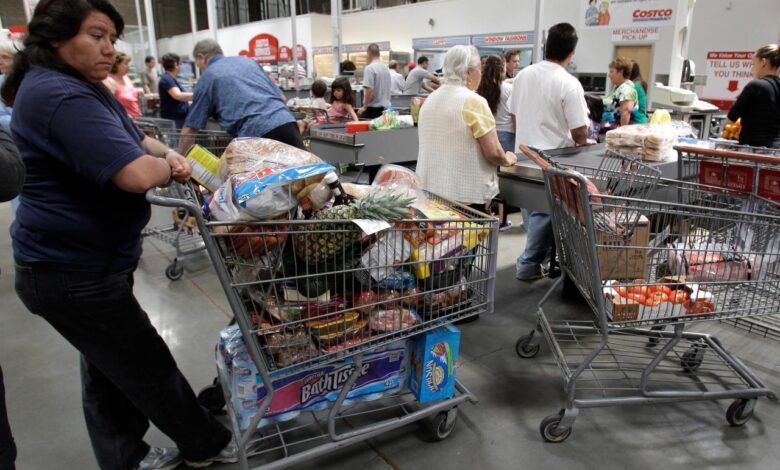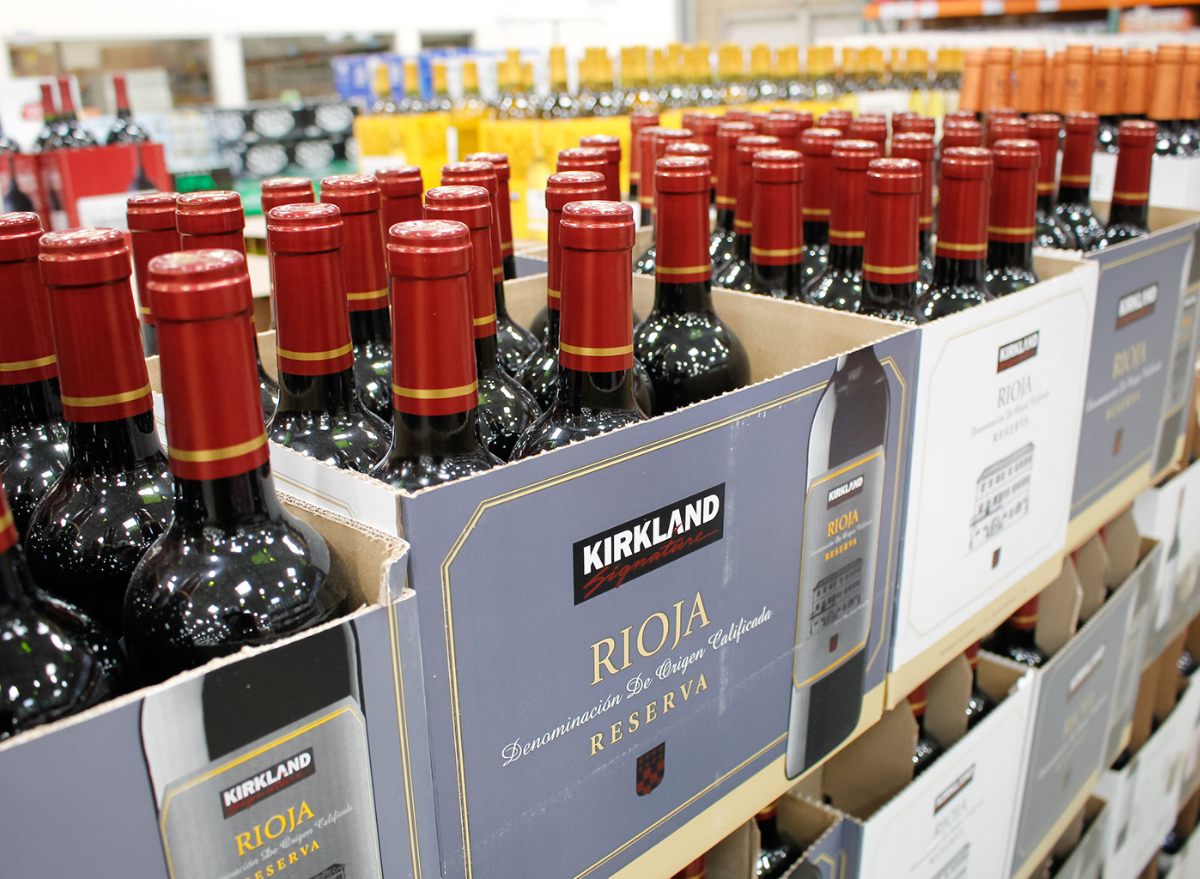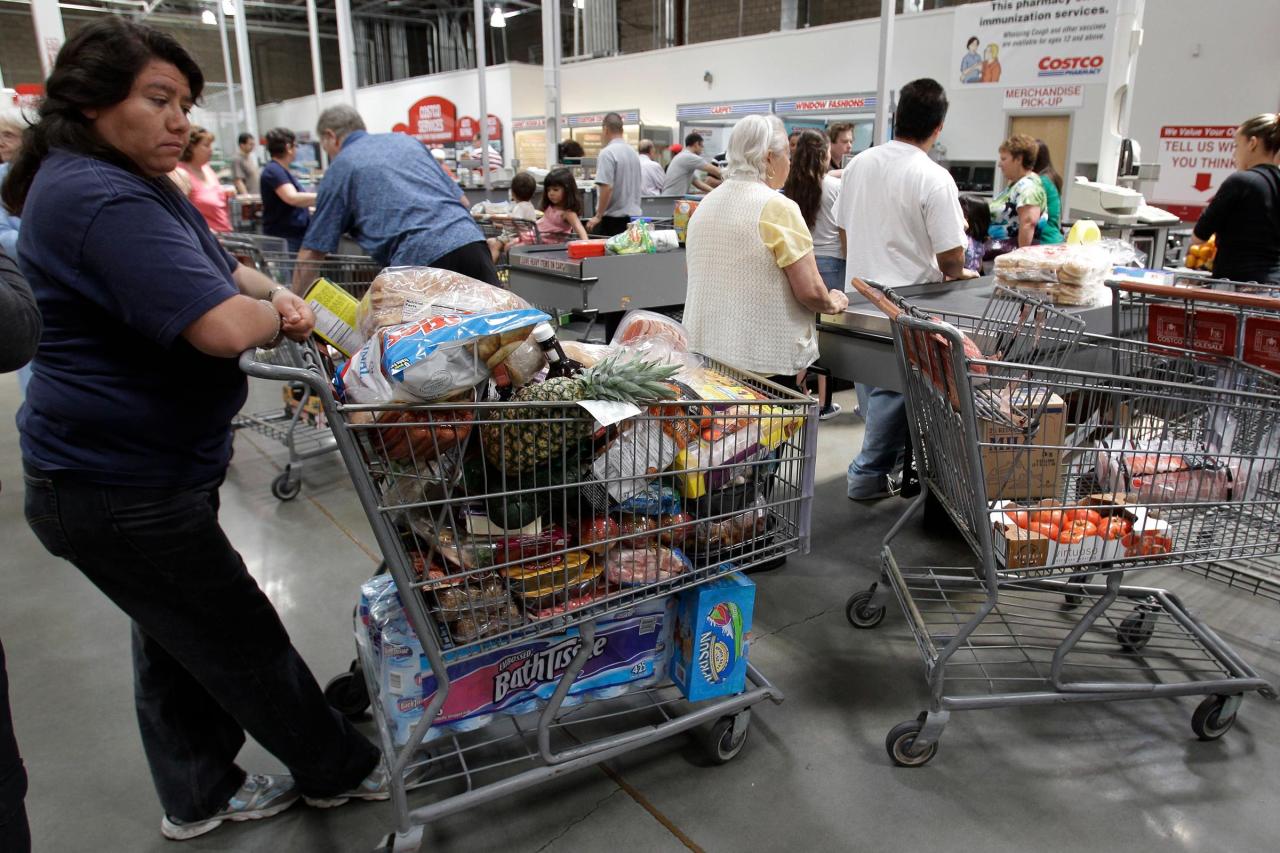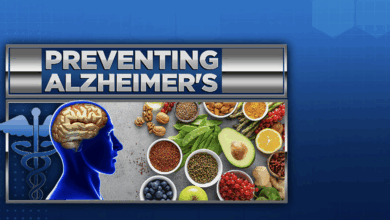
How does shopping at Costco affect your eating habits? Costco’s bulk-buying model drastically alters grocery shopping routines, leading to significant changes in meal planning, food consumption, and even food waste. This exploration delves into the multifaceted ways Costco’s influence ripples through your daily life, from weekly trips to your pantry, impacting your budget, health, and overall eating habits.
From the sheer volume of products available in massive quantities to the pre-packaged meals, Costco offers a unique shopping experience. Understanding the implications of this approach is crucial to making informed decisions about your food choices and maintaining a healthy relationship with your grocery budget.
Impact on Grocery Shopping Habits
Costco’s bulk purchasing model has a profound effect on how people shop for groceries. It’s not just about saving money; it fundamentally alters the way we approach weekly provisions. This shift in habits extends beyond simply buying more; it impacts the frequency of trips, the planning involved, and even the contents of our shopping carts. Let’s delve into how Costco’s unique approach influences our grocery shopping routines.
Frequency of Grocery Shopping Trips
Costco’s bulk purchasing model fundamentally alters the frequency of grocery shopping trips. The availability of large quantities of products, from cereal to cleaning supplies, encourages customers to stock up, reducing the need for frequent visits to other stores. This contrasts sharply with the weekly trips to traditional supermarkets, where smaller quantities are purchased more often. The expectation is that Costco shoppers will make fewer trips to the store, potentially saving time and fuel.
Comparison with Traditional Grocery Stores
The experience at Costco differs significantly from that of traditional grocery stores. Traditional grocery stores, with their smaller package sizes and wider selection of specific items, often necessitate more frequent trips to meet the demands of daily life. Costco’s model, on the other hand, is geared towards larger purchases and longer-lasting supplies, making it an attractive option for households seeking a less frequent shopping experience.
Planning and Execution of Grocery Shopping
Costco’s large quantities necessitate a different approach to grocery shopping. Shoppers must plan their purchases meticulously, considering family size, dietary needs, and anticipated consumption rates. The availability of large containers, family-sized packages, and even multi-packs requires careful inventory management. This proactive approach to shopping often results in more detailed meal planning to utilize the bulk purchases effectively.
Increased or Decreased Grocery Shopping Frequency
Costco’s pricing and selection can lead to both increased and decreased grocery shopping frequency. The allure of discounted bulk pricing and a wide range of products often encourages a larger shopping trip. However, the sheer quantity of goods purchased can sometimes overwhelm the shopper, leading to a less frequent need for further purchases. Ultimately, the frequency depends on individual shopping habits and household needs.
Comparison of Weekly Shopping Patterns
| Characteristic | Costco Shoppers | Non-Costco Shoppers |
|---|---|---|
| Frequency of trips | 1-2 times per month | 2-3 times per week |
| Quantity purchased | Larger quantities (e.g., 24-pack soda, 5-pound bags of rice) | Smaller quantities (e.g., 6-pack soda, 1-pound bags of rice) |
| Shopping cart size | Often large, filled to the brim with bulk items | Smaller, with a mix of individual items |
| Planning | Extensive meal planning, often with shopping lists and spreadsheets | More spontaneous shopping, often relying on immediate needs |
This table highlights the distinct differences in weekly shopping patterns. Costco shoppers plan their purchases with a longer-term perspective, while non-Costco shoppers often respond to immediate needs.
Shopping Carts or Baskets
The shopping carts or baskets used by Costco shoppers often differ significantly from those of traditional grocery store shoppers. Costco shoppers frequently use large, sturdy carts capable of holding significant bulk purchases. The carts are typically filled to capacity, showcasing the volume of goods purchased. In contrast, traditional grocery store shoppers often use smaller carts or baskets, carrying a variety of individual items for immediate needs.
Influence on Food Consumption Patterns
Costco’s unique shopping experience, with its massive quantities and diverse product offerings, undeniably shapes how we consume food. The abundance of readily available, pre-packaged items, coupled with the allure of bulk purchases, can significantly impact our eating habits, whether we intend it or not. This section will delve into how Costco’s influence manifests in our daily food choices and meal planning.
Impact of Large Portion Sizes and Product Variety
Costco’s large portion sizes, particularly on staples like rotisserie chicken or family-sized bags of chips, often lead to overconsumption. The sheer quantity presented can encourage impulse purchases and overeating, even if the food itself is nutritious. The wide variety of products, from exotic fruits to international snacks, also presents a challenge for dietary adherence. The sheer availability of tempting options can disrupt established eating patterns and lead to occasional deviations from planned meals.
Influence of Pre-packaged Meals and Snacks
Pre-packaged meals and snacks at Costco offer convenience, but can also lead to a reliance on processed foods. Their accessibility and ease of preparation make them appealing, particularly for busy individuals or families. However, this convenience can often come at the cost of nutritional value. The availability of pre-made options may inadvertently reduce the time and motivation to prepare more nutritious homemade meals.
Impact of Bulk Purchases on Food Consumption
Bulk purchases at Costco encourage the consumption of certain food items. The cost-effectiveness of purchasing large quantities often leads to increased consumption of those items, even if they aren’t always part of a regular diet. For instance, a large bag of rice or beans might be purchased for their affordability, leading to a greater consumption of these items than would be the case with smaller purchases.
The availability of large quantities also fosters experimenting with new foods, sometimes leading to incorporating them into regular meals.
Comparison of Dietary Habits Between Costco Shoppers and Non-Costco Shoppers
Costco shoppers may exhibit different dietary habits compared to those who don’t shop at Costco. Costco shoppers often rely more on pre-packaged items and bulk purchases, leading to potentially higher consumption of certain foods, especially those available in large quantities. Non-Costco shoppers, on the other hand, may prioritize fresh produce and homemade meals more frequently.
Impact on Meal Planning
Costco’s influence on meal planning is significant. The sheer volume of products and bulk purchasing options often necessitates a more structured meal planning approach. Weekly meal plans become crucial for managing the large quantities of food and preventing food waste. Shopping lists are also critical to avoid impulsive purchases and stay within planned budgets.
Typical Food Categories and Quantities Purchased at Costco
| Food Category | Typical Quantity Purchased |
|---|---|
| Meat (e.g., rotisserie chicken, steaks) | Large portions (e.g., multiple whole chickens, large cuts of meat) |
| Produce (e.g., fruits, vegetables) | Bulk quantities, often in pre-cut or pre-packaged formats |
| Grains (e.g., rice, pasta) | Large bags or containers |
| Dairy (e.g., cheese, yogurt) | Large tubs or blocks |
| Snacks (e.g., chips, candy) | Large packages |
| Beverages (e.g., juices, sodas) | Large bottles or cartons |
Note: This table provides a general overview. Actual quantities may vary significantly depending on individual needs and preferences.
Impact on Food Waste
Costco’s bulk purchasing model presents a unique challenge and opportunity regarding food waste. While the allure of discounted prices and large quantities is undeniable, the sheer volume of food purchased can lead to significant spoilage if not properly managed. This section delves into the relationship between Costco’s bulk buying and food waste, exploring strategies to mitigate spoilage and comparing waste levels across different shopping habits.The sheer volume of food bought at Costco, while offering potential savings, often results in substantial food waste if not carefully planned and managed.
Smart shopping habits and proper storage techniques are crucial to minimize the environmental and financial impact of this large-scale purchasing.
Relationship Between Bulk Buying and Food Waste
Costco’s bulk buying model inherently increases the risk of food waste. Customers often purchase more food than they can realistically consume within the recommended shelf life, leading to spoilage if not properly managed. The larger quantities purchased mean more chances for items to be forgotten in the back of the refrigerator or pantry, contributing to wasted food.
Strategies to Minimize Food Waste
Effective planning and organization are key to minimizing food waste when shopping at Costco. Creating a meal plan and grocery list based on the family’s needs and dietary preferences helps prevent overbuying. Shoppers should be mindful of the quantities needed for a specific period, rather than buying based on the lowest price per unit. Proper storage and rotation techniques, including using airtight containers, freezer bags, and rotating older items to the front of the fridge, are crucial.
Managing and Storing Large Quantities
Proper storage is essential for preserving the quality and freshness of Costco’s bulk purchases. Using airtight containers for leftovers and storing perishable items in the refrigerator or freezer is critical. Freezer-safe containers are ideal for freezing excess produce or cooked meals to extend their lifespan. Clear labeling of containers with the date of purchase and contents is also important to ensure proper rotation.
Comparison of Food Waste Levels
Direct comparisons of food waste levels between Costco shoppers and those shopping elsewhere are difficult to quantify. However, anecdotal evidence suggests that Costco shoppers, due to the larger quantities they purchase, face a greater potential for waste if not mindful of their consumption patterns. General grocery shoppers with a more targeted approach to purchasing tend to have less waste.
Impact of Costco’s Return Policies on Food Waste
Costco’s return policy significantly influences food waste. While Costco does not accept the return of most perishable items, customers can still minimize waste by careful consideration of the intended use and estimated consumption. Purchasing only what is needed for the immediate timeframe helps to avoid the issue of perishable items expiring before they are consumed.
Frequency of Food Waste
| Shopping Location | Frequency of Food Waste (Estimated) |
|---|---|
| Costco | High (if not managed properly) |
| Other Grocery Stores | Moderate (if not managed properly) |
Note: This table provides an estimated comparison and is not based on statistically significant data. The frequency of food waste depends heavily on the individual shopper’s habits and management strategies.
Financial Implications
Costco’s bulk purchasing model offers significant potential for cost savings, but its impact on household budgets is complex. Understanding the interplay between bulk pricing, membership fees, and overall grocery spending is crucial to determining if Costco is a financially viable option. The allure of lower prices often overshadows the need for careful budgeting and mindful consumption to maximize these savings.The financial implications of shopping at Costco extend beyond simply purchasing groceries.
Costco’s massive portions and tempting deals can definitely impact your eating habits. It’s easy to buy way more than you need, leading to leftovers piling up and potentially overeating. This is especially true for women in their 30s who are navigating the complexities of family planning, like the recent trend of more women in their 30s having babies than 20s , and who may be juggling busy schedules.
Ultimately, the sheer volume of food available at Costco can make it harder to maintain healthy eating habits if you’re not mindful of portion sizes.
Strategic planning and awareness of Costco’s pricing strategies are key to achieving a positive return on investment. By understanding how Costco’s bulk buying model impacts the overall cost of groceries, consumers can make informed decisions about their grocery shopping habits and potentially save money.
Cost Savings from Bulk Purchases
Costco’s bulk purchasing power allows for lower prices per unit, a key driver of savings. This bulk pricing strategy benefits consumers by offering lower unit prices compared to traditional grocery stores, often leading to significant savings when buying in larger quantities. However, these savings are contingent on the consumer’s ability to effectively utilize the bulk purchases. Overstocking and subsequent food waste can diminish the overall cost savings.
Comparison of Grocery Shopping Costs
Comparing the overall cost of grocery shopping at Costco with traditional grocery stores reveals a complex picture. While Costco frequently offers lower prices on certain items, the overall cost may not always be lower, particularly if consumers are not utilizing Costco’s bulk-buying strategy effectively. The difference in cost often depends on the specific items purchased and the consumer’s individual consumption patterns.
Impact of Pricing Strategies
Costco’s pricing strategies, which often involve a combination of lower prices on select items and higher prices on others, influence food spending habits. The strategy is designed to encourage bulk purchases and entice customers to buy more than they typically would. Consumers need to be aware of these strategies to avoid overspending and maintain a balanced budget.
Examples of Cost Savings
Costco’s bulk buying can lead to substantial cost savings. For example, purchasing a large container of laundry detergent or a 12-pack of paper towels at Costco may cost less per unit than purchasing the same items in smaller quantities at a traditional grocery store. However, the consumer must factor in the potential for food waste or the need to store the large quantities.
Impact of Membership Fees
Costco membership fees are a crucial factor in the overall financial implications of shopping there. The membership fee acts as a barrier to entry, and consumers need to weigh the potential cost savings against the membership cost. The savings must be significant enough to justify the membership fee. The value proposition of the membership should be analyzed on a case-by-case basis, considering individual shopping habits and consumption patterns.
Cost Comparison Table
| Product | Costco | Traditional Grocery Store | Savings |
|---|---|---|---|
| 12-pack of paper towels | $10.99 | $12.99 | $2.00 |
| 1 Gallon of milk | $3.49 | $3.99 | $0.50 |
| 12-pack of soda | $14.99 | $16.99 | $2.00 |
| 5-pound bag of potatoes | $3.99 | $4.49 | $0.50 |
Note: Prices are examples and may vary depending on location and specific store.
Health and Dietary Considerations
Costco’s bulk buying model, while offering significant price advantages, can have a profound impact on our health and dietary habits. The sheer volume of food available, combined with the attractive pricing, often leads to purchasing more than one person needs, potentially altering our dietary choices and impacting our overall well-being. Understanding the potential pitfalls and proactively adjusting our consumption patterns can help us maximize the benefits of Costco while minimizing any negative consequences.
Potential Health Benefits of Costco Food
Costco’s wide selection of fresh produce, meats, and pantry staples can provide access to healthy options at competitive prices. The large quantities allow for stocking up on staples like fruits, vegetables, and whole grains, encouraging a more varied diet. The availability of organic and natural products, while sometimes at a premium, can provide healthy alternatives to processed foods.
Many Costco members find the ease of bulk purchasing facilitates healthy meal preparation at home.
Potential Drawbacks of Costco’s Food Offerings
While Costco offers convenient bulk purchasing, the large portion sizes can lead to overconsumption, potentially contributing to weight gain or an imbalance in dietary intake. The abundance of processed and packaged foods, while sometimes cost-effective, may compromise the nutritional value of a diet focused on whole foods. The large quantities of certain items can lead to spoilage if not stored and consumed properly.
It’s crucial to be mindful of portion sizes and to plan meals strategically to avoid excessive intake of less healthy options.
Impact on Dietary Choices Due to Costco’s Variety and Quantity
The extensive variety at Costco can tempt consumers to stray from their usual dietary patterns. The presence of a wide array of tempting snacks, desserts, and convenience foods can make it difficult to stick to a predetermined dietary plan. This abundance of choices, combined with large quantities, can influence dietary decisions, leading to increased consumption of items that might not align with a healthy eating plan.
For instance, a Costco trip for staples might end up with a substantial purchase of tempting treats.
Costco’s massive portions and tempting deals can seriously throw off your eating habits. Suddenly, you’re home with enough food to feed a small army, and it’s easy to overeat. This can definitely impact your journey toward getting in shape for surgery, getting in shape for surgery. It’s crucial to be mindful of portion sizes and make healthy choices when you’re shopping there.
Planning your meals ahead of time and sticking to a healthy grocery list can make a big difference.
Influence of Costco Products on Portion Sizes and Consumption
Costco’s focus on large portions can influence consumption patterns. The sheer size of packages and servings can lead to consuming more food than is truly needed. This can contribute to overeating and hinder efforts to maintain a balanced diet. Individuals need to be mindful of portion control when purchasing and consuming items from Costco to prevent overconsumption.
Consciously measuring portions and distributing purchases across several meals can help control this effect.
Potential Nutritional Imbalances
Relying heavily on Costco for groceries could lead to nutritional imbalances. The abundance of processed foods, sugary drinks, and less healthy options can overshadow the nutritional benefits of fresh produce and whole grains. A diet reliant on Costco could lack essential vitamins and minerals if not supplemented with a conscious effort to include a variety of foods. This emphasizes the importance of incorporating a wider range of foods into the weekly diet.
Those Costco runs can seriously impact your diet! The sheer volume of tempting, often oversized, packages makes it easy to overbuy. But, if you’re looking to manage your food intake and build healthy habits, consider exercise like an olympian with this insider knowledge to help you develop a structured approach to your workouts. Ultimately, mindful shopping and a balanced exercise routine are key to controlling your eating habits at Costco and beyond.
Importance of Mindful Consumption When Shopping at Costco, How does shopping at costco affect your eating habits
Mindful consumption is paramount when shopping at Costco. It’s crucial to create a shopping list and stick to it, prioritizing healthy options. Portion control is essential, as is careful consideration of individual dietary needs. Planning meals ahead of time can help to avoid impulse purchases and ensure that Costco purchases complement a healthy dietary pattern. Thorough meal planning and portion control are crucial steps.
Comparison of Nutritional Content
| Product | Costco | Other Stores |
|---|---|---|
| Chicken Breast (8oz) | ~250 Calories, ~30g Protein | ~220 Calories, ~30g Protein |
| Ground Beef (1lb) | ~600 Calories, ~25g Protein | ~550 Calories, ~25g Protein |
| Bag of Apples | ~500g, ~250 Calories | ~500g, ~200 Calories |
| Bag of Potato Chips (Large) | ~450 Calories, ~10g Protein | ~350 Calories, ~5g Protein |
The table above provides a simplified comparison of nutritional content. Specific values will vary depending on the exact product and brand. Always consult product labels for precise nutritional information. Note that the differences in nutritional content might be minimal, but they can add up when considering overall dietary choices.
Illustrative Examples

Costco’s impact on shopping habits extends far beyond just the initial purchase. The sheer volume and variety of products available at Costco, combined with its unique pricing model, fundamentally alters how families approach grocery shopping and meal planning. This section provides concrete examples of these changes, highlighting both the positive and potential negative consequences.
Impact on Daily Meals
Costco’s bulk purchases often lead to a shift in daily meals. Families might find themselves routinely eating the same meals, driven by the large quantities of food available. For instance, a family purchasing a large rotisserie chicken can enjoy it for several meals, perhaps with different sides like salads or rice. This predictable meal structure, while convenient, can sometimes lead to a less diverse diet if not carefully managed.
Similarly, buying a large container of frozen vegetables can provide a readily available, nutritious side dish for many dinners.
Influence on Family Dietary Habits
Costco’s influence on family dietary habits is multifaceted. The wide array of options, from ethnic foods to specialty items, can expose families to new flavors and ingredients. However, the abundance of processed foods and snacks in bulk packages can also contribute to less-healthy choices. Conscious meal planning and mindful selections within Costco’s offerings are key to ensuring a balanced dietary approach.
For example, a family might discover a love for new ethnic cuisines by purchasing large quantities of pre-portioned meals, which can then be incorporated into their weekly meal rotation.
Strategies to Avoid Food Waste
Costco’s bulk purchases inherently raise the risk of food waste if not managed effectively. Strategic meal planning is crucial. Create a detailed weekly meal plan, factoring in Costco purchases. Proper storage is equally important. Freezing leftovers and portioning items effectively can significantly reduce food waste.
Freezing leftovers from large rotisserie chickens into single-serving portions for future quick meals is a common strategy.
Cost Savings from Bulk Purchases
Costco’s bulk pricing model can lead to significant cost savings. The apparent high price of a large package might seem counterintuitive. However, the actual unit cost often proves lower than comparable smaller packages from other retailers. This is particularly true for staples like rice, beans, or pasta. Comparing unit prices from Costco to traditional grocery stores is essential for maximizing savings.
Impact on Meal Planning and Preparation
Costco’s bulk purchases necessitate adjustments to meal planning. Families need to consider how to incorporate the larger quantities into their regular meals. Meal prepping for the week becomes a vital aspect of utilizing Costco purchases effectively. A family might prepare large batches of chili or soup on the weekend, then portion it out for easy reheating throughout the week.
This approach not only reduces cooking time during the week but also minimizes waste.
Summary Table of Meals and Snacks
| Meal/Snack Category | Costco Product | Preparation Notes |
|---|---|---|
| Protein | Rotisserie Chicken, Ground Beef, Salmon | Portion and freeze for individual meals; use for salads, sandwiches, tacos |
| Grains | Large bags of rice, pasta | Cook in large batches and store for various meals; use as a base for stir-fries or salads |
| Produce | Large bags of frozen vegetables, fresh fruit | Use in soups, stews, or as side dishes; make smoothies or fruit salads |
| Snacks | Bulk nuts, dried fruit, popcorn | Portion into containers for easy access; healthy and convenient alternatives |
| Other | Ethnic foods, pre-made meals | Try new cuisines; great for quick and easy meals |
Final Review: How Does Shopping At Costco Affect Your Eating Habits

In conclusion, shopping at Costco can profoundly reshape your eating habits. The convenience of bulk purchases, combined with competitive pricing, often results in significant cost savings, but this comes with potential trade-offs. Increased food waste and potential for unhealthy dietary choices are real concerns. Ultimately, navigating the Costco experience requires a mindful approach to planning, portion control, and careful consideration of your overall dietary goals.





